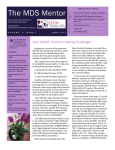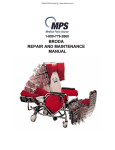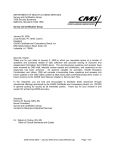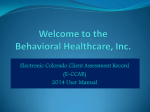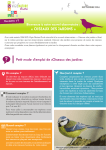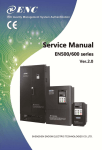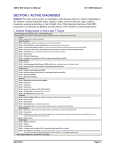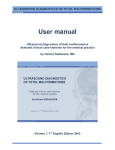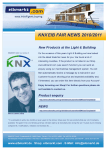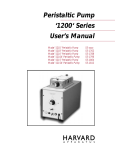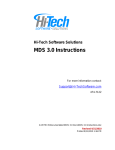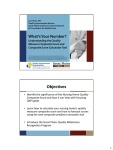Download RAI Newsletter
Transcript
RAI Spotlight Newslet ter Title R A I C o o r d i n a t or 1-717-787-1816 qa -m ds @ pa . gov R AI C o o r d i n a t o r 1-717-787-1816 Surveyor Access to EHRs In early February, a reminder was posted on the Department of Health message board to facilities that use Electronic Health Records (EHR.) Providers must allow access to any medical record, including access to EHRs, when requested by the surveyor. It is the facility’s responsibility to provide direction on the use of the electronic system or to designate an individual to access the system in response to questions or to assist the survey team. A delay in the acquisition of the medical record is unacceptable and may delay the survey process. Delaying the access or impeding the survey process would warrant contact by the State Agency to CMS which may lead to termination from Medicare participation. To facilitate the survey process if your facility utilizes EHRs, a good first step is to be proactive. Keep in mind that Department of Health surveys are unannounced, so be sure to have a plan ready! Being prepared will enable you to meet the Department’s expectation of [email protected] access to EHRs within two hours of the survey team’s arrival. Here are some other helpful tips: • Make sure that the user names and passwords assigned to surveyors work properly. • Provide instructions for navigating your system and designate a staff member to be a resource for surveyors if they require assistance accessing EHRs. • Assure that surveyors are able to access EHRs on devices in resident care areas as well as other areas such as conference rooms. • Survey teams may include four or more staff members, so make sure there is adequate equipment available. (Continued on page 3) Section J Health Conditions Teleconference S econdary S t ory He adl ine Date: April 17, 2014 Time: 1:30 – 2:30 pm EDT (Dial-in 10 minutes earlier) Your headline is an important part of the newsletter and should be considered careTopic: Section J Health Conditions fully. Handouts: Power Point slides will be available about April 14 on In a few words, it should accurately represent the contents of the story and draw the Develop DOH Message Board readers into the story. the headline beforeatyou write the story. This way, the This story can fit 75-125 words. http://app2.health.state.pa.us/commonpoc/content/facilityweb/login.asp headline will help you keep the story focused. Call in number: 1-888-694-4728 or 1-973-582-2745 Examples of possible headlines include Product Wins Industry Award, New Product Conference ID Number: Can Save You Time!, Membership88715377 Drive Exceeds Goals, and New Office Opens Near You. Company Name: Myers and Stauffer Moderator: Cathy Petko A recording of this conference will be available; directions for requesting this will be posted on the DOH Message Board. Additional questions: [email protected] Volume 8, Issue 3 February 2014 Questions about the RAI? Please submit them to [email protected] Inside this issue: Section H Bowel and Bladder Q & As 2 COT Questions 2 Quality Care in Nursing Facilities 2 Be Careful of These Numbers! 3 Preparing for ICD-10-CM 3 Volume 8, Issue 3 Page 2 Section H Bowel and Bladder Q & As On January 16, 2014, a training teleconference was provided on Section G Functional Status Items G0120 through G0900, and Section H Bowel and Bladder. No questions were received during the teleconference but the following questions were received through the DOH mailbox: Q. Can you provide some examples of obstructive uropathy? A. Obstructive uropathy occurs when urine cannot drain through a ureter/urethra, potentially flowing back up into the kidney causing hydronephrosis. Common causes of obstructive uropathy include bladder stones, kidney stones, benign prostatic hyperplasia and bladder or ureteral cancer. As with all diagnoses, in order to code obstructive uropathy (MDS Item I1650) on the MDS, all of the criteria stated in the RAI User’s Manual for coding an active diagnosis must be met. Q. In coding G0600, is the only acceptable chair a wheelchair? A. Yes. CMS has clarified in the past that Geri Chairs, Broda chairs, and other chairs with wheels are not to be coded as wheelchairs on the MDS in item G0600. Q. In regards to Functional Limitation in Range of Motion coding: If a resident has a cast, are we to assume that they are always considered to have an impairment on one side and be coded as a 1 due to immobility, or can we more specifically look at the fact that the resident who is unable to move due to being in a cast yet is casted in a functional ROM of neutral which is not impeding her ability to mobilize or perform tasks be considered a 0 as it is not impairing their mobility or self care? In most cases, a resident in a cast has a functional limitation due to a non-weight bearing status/altered weight bearing status and not due to the immobility of a limb. A joint casted in neutral although immobile does not impede a resident’s ability to mobilize or perform ADLs; in some case it may even assist. The decreased ability to perform mobility or ADLs is due to the resident’s inability to maintain non-weight bearing status in attempts to transfer or stand to put pants on for example, and not due to the fact that their ankle is immobile. A. As stated in the coding instructions, “Do not look at limited ROM in isolation. You must determine if the limited ROM impacts functional ability or places the resident at risk for injury.” The coding of this item will be resident specific, dependent on the impact to that resident. COT Questions Judging by calls received, there is continuing confusion as to when COT and PPS assessments should be combined. Guidance in the RAI Manual is somewhat conflicting: “If Day 7 of the COT observation period falls within the ARD window (including grace days) of a scheduled PPS Assessment, and the ARD of the scheduled PPS assessment has not been set for a day that is prior to Day 7 of the COT observation period, and a COT OMRA is deemed necessary upon completion of the change of therapy evaluation, than the SNF must combine the COT OMRA and the scheduled assessment.” (RAI Manual page 2-55) The emphasis in this instruction is to convey that two separate assessments cannot be performed in the ARD window, e.g., a 14-day assessment on Day 13 and a COT on Day 15 or vice versa. If both must be completed, they must be combined with the ARD on Day 7 of the COT observation period. Additional instruction is provided on page 2-51: “If Day 7 of the COT observation period falls within the ARD window of a scheduled PPS Assessment, the SNF may choose to complete the PPS Assessment alone by setting the ARD of the scheduled PPS assessment for an allowable date that is on or prior to Day 7 of the COT observation period. This effectively resets the COT observation period to the 7 days following that scheduled PPS Assessment ARD. Alternately, the SNF may choose to combine the COT OMRA and scheduled assessment following the instructions discussed in Section 2.10.” The SNF has the option to perform only the scheduled PPS assessment, e.g., if Rehabilitation group is now at a lower level, or to combine the scheduled PPS assessment with a COT if the Rehabilitation group will be at a higher level and the SNF wants to capture the higher rate for the previous 7 days. The SNF must evaluate each individual situation to identify which pattern of assessment completion will be of benefit to the facility and still follow RAI Manual instructions. Another bullet on page 2-51 states: “The COT ARD may not precede the ARD of the first scheduled or unscheduled PPS assessment of the Medicare stay used to establish the patient’s current RUG-IV therapy classification.” A COT cannot be used as the first assessment to establish a Rehabilitation RUG. If the COT results in a Nursing RUG rather than a Rehabilitation RUG, only the next scheduled PPS assessment can restart the Rehabilitation RUG if therapy has increased. CMS is evaluating this situation. Quality Care in Nursing Facilities Everyone wants quality care to be provided in the nursing facility. In an effort to identify quality care and ensure its provision, many organizations and programs have been developed, often leading to confusion. CMS has released a document outlining several of the programs and responding to Frequently Asked Questions (www.cms.gov/Medicare/Provider-Enrollment-and-Certification/QAPI/Downloads/Aligning_QAPI_FAQ.pdf ). Guidance is provided about the various programs, their implementation and integration. Volume 8, Issue 3 Page 3 Be Careful of These Numbers! CMS has been tightening MDS edit requirements in order to ensure greater data accuracy particularly in facility identifiers. What are these numbers? • FAC_ID – This is the number assigned by the state agency to the nursing home and reported in the Control Section of the MDS file. For most facilities in PA, this number starts with ‘PA’. It is automatically filled in by your software, so if there are issues, you may need to contact your vendor. • A0100A Facility National Provider Identifier (NPI) – The NPI is a unique 10-digit identification number issued to health care providers in the United States by CMS. • A0100B Facility CMS Certification Number (CCN) – This is often referred to as the Medicare number. It must be six digits/letters long. In Pennsylvania, it often starts with ‘39’. • A0100C State Provider Number – This is often referred to as the Medicaid number. This is the 13-digit MA number that is used in the PROMISe system. If your facility does not participate in the MA program, this item may be left blank (^). CMS is comparing these numbers on submitted assessments to assure that they all belong to the same provider and to be certain they match the numbers in the CMS database. It is very important that these numbers be correct so the residents and assessments are properly assigned to your facility, particularly if there has been a Change of Ownership (CHOW). If you have been receiving an error on your Final Validation Report related to these numbers, contact the Myers and Stauffer Help Desk for assistance (717-541-5809). Preparing for ICD-10-CM Beginning on October 1, 2014, every entity covered by the Health Insurance Portability and Accountability Act (HIPAA) must use the International Classification of Diseases, 10th edition (ICD-10-CM) rather than ICD-9 codes. There is no grace period: forms or transactions with a date on or after October 1, 2014 must use ICD-10 codes or be rejected. Forms or transactions with a date on or before September 30, 2014, must use ICD-9 codes. This affects both Medicare and Medicaid programs. CMS has developed many materials to aid in the transition (www.cms.gov/Medicare/Coding/ICD10/2014-ICD-10CM-and-GEMs.html). A Frequently Asked Questions document on ICD-10 Transition Basics (www.cms.gov/ Medicare/Coding/ICD10/Downloads/ICD10FAQs2013.pdf) is a good introduction. Evaluate where ICD-9 codes are used in your facility such as MDS completion and the billing department, and begin to plan for the transition. In another necessary change to support ICD-10, NFs must begin using CMS-1500 Health Insurance Claim Form (version 02/12) on July 1, 2014 (www.dpw.state.pa.us/ publications/bulletinsearch/ bulletinselected/index.htm?bn=99-14-03). Claims received on or after July 1, 2014 using previous versions of the form will be returned to the provider. All Pennsylvania Medical Assistance enrolled individual providers, provider groups, clearing houses, software vendors, billing services, and managed care organizations must convert to ICD-10 on October 1, 2014. The Department will make all necessary changes in PROMISe to support the ICD-10 requirements. A dedicated web page has been added to the Department’s provider information website at www.dpw.state.pa.us/provider/icd10informations/ P_012571. Documents of special interest are the Provider Quick Tips (www.dpw.state.pa.us/publications/ forproviders/QuickTips/P_039560) and ICD-10 FAQs (www.dpw.state.pa.us/provider/icd10information/icd10faqs/ indes.htm). October will be here shortly. Be certain your facility is ready to smoothly transition to the new coding system! Surveyor Access to EHRs (cont’d) (Continued from page 1) • Be prepared to print documents and records from your system when the surveyors request hard copies. • If your facility uses both paper records and EHRs, communicate to the survey team what records are maintained in each format. The reference number for the CMS Survey and Certification Memo regarding the subject of surveying facilities that use electronic health records (EHR) is S&C-09-53, and can be downloaded from the CMS website http://www.cms.gov/ Medicare/Provider-Enrollment-and-Certification/ SurveyCertificationGenInfo/Policy-and-Memos-to-Statesand-Regions.html.



